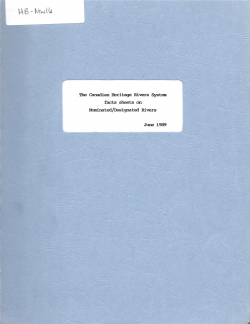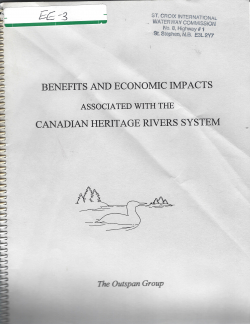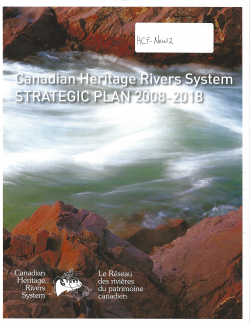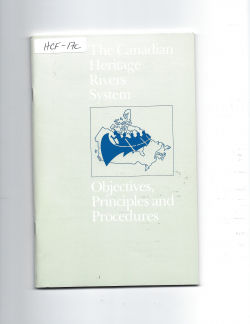Canadian Heritage Rivers System - Recreational Carrying Capacity Study
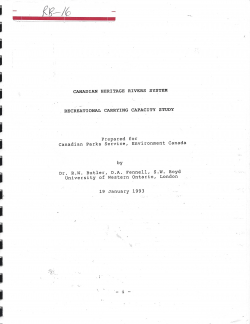
Type
Publication
Category
SCIWC Library
[ Browse Items ]
Publication Year
1993
Pages
132
Subject
Canadian Heritage Rivers System Carrying Capacities
Tags
Abstract
“Preface
This document contains the results of work carried out by the authors under contract to the Canadian Parks Service in 1991 and 1992. As part of its support for the Canadian Heritage Rivers System, CPS undertakes a number of thematic studies of practical means of estimating the carrying capacity of rivers was identified by the Canadian Heritage Rivers Board as one such subject.
The project was completed in 1992 in two phases: the development of the POLAR model for assessing carrying capacities of rivers, and the field testing of this model on a section of the Churchill River, Saskatchewan.
The first part of this document describes the concept of carrying capacity and various existing methods for assessing recreational carrying capacity. This is followed by a description of the POLAR (Procedure for Operationalizing Limits for the Administration of Rivers) model and the procedure for using the POLAR model for a specific river. The model is a general one, designed to have applicability for all rivers in the Canadian Heritage Rivers System, and probably on many others in North America.
The second part of the document, beginning at Chapter 4, is a description of the testing of the POLAR model on the Churchill River. The model helped to reveal that, overall, there are no severe problems relating to the recreational use of the Churchill River study area, and that the quality of the recreational experience is generally high.
Three management options are outlined following the testing of the method on the Churchill river. Each is an attempt to outline a realistic scenario for possible government action. Option one describes a “hands-on” proposal to maintain a near-wilderness experience similar to the rest of the river. Option two describes a situation where limited control of activities is imposed, in order to prevent further intensive use developments. Option 3 describes a “hands-off” approach where all forms recreation are permitted and compatible ones are unrestricted. In Chapter 7, the effectiveness of the POLAR model, based on the field testing, is assessed.
Finally, in Chapter 8, there is a fairly comprehensive review of existing literature on carrying capacity, some of which was used in developing the POLAR method. This bibliography begins with a review of carrying capacity in a recreation context, followed by an introduction to literature pertaining to carrying capacity related to river recreation. The primary emphasis was given to material published in the last decade because approaches to studying this topic and the underlying philosophy towards carrying capacity in a recreation context have changed significantly over the last ten to fifteen years.”
This document contains the results of work carried out by the authors under contract to the Canadian Parks Service in 1991 and 1992. As part of its support for the Canadian Heritage Rivers System, CPS undertakes a number of thematic studies of practical means of estimating the carrying capacity of rivers was identified by the Canadian Heritage Rivers Board as one such subject.
The project was completed in 1992 in two phases: the development of the POLAR model for assessing carrying capacities of rivers, and the field testing of this model on a section of the Churchill River, Saskatchewan.
The first part of this document describes the concept of carrying capacity and various existing methods for assessing recreational carrying capacity. This is followed by a description of the POLAR (Procedure for Operationalizing Limits for the Administration of Rivers) model and the procedure for using the POLAR model for a specific river. The model is a general one, designed to have applicability for all rivers in the Canadian Heritage Rivers System, and probably on many others in North America.
The second part of the document, beginning at Chapter 4, is a description of the testing of the POLAR model on the Churchill River. The model helped to reveal that, overall, there are no severe problems relating to the recreational use of the Churchill River study area, and that the quality of the recreational experience is generally high.
Three management options are outlined following the testing of the method on the Churchill river. Each is an attempt to outline a realistic scenario for possible government action. Option one describes a “hands-on” proposal to maintain a near-wilderness experience similar to the rest of the river. Option two describes a situation where limited control of activities is imposed, in order to prevent further intensive use developments. Option 3 describes a “hands-off” approach where all forms recreation are permitted and compatible ones are unrestricted. In Chapter 7, the effectiveness of the POLAR model, based on the field testing, is assessed.
Finally, in Chapter 8, there is a fairly comprehensive review of existing literature on carrying capacity, some of which was used in developing the POLAR method. This bibliography begins with a review of carrying capacity in a recreation context, followed by an introduction to literature pertaining to carrying capacity related to river recreation. The primary emphasis was given to material published in the last decade because approaches to studying this topic and the underlying philosophy towards carrying capacity in a recreation context have changed significantly over the last ten to fifteen years.”
Description
This document was developed by The Canadian Heritage Rivers System as an examination of Carrying Capacity amongst Recreational designated Heritage Rivers. The Churchill River that flows through Manitoba, Saskatchewan, and Alberta is used as an example to illustrate that method of analysis for determining Carrying Capacity.
Number of Copies
1
| Library | Accession No | Call No | Copy No | Edition | Location | Availability |
|---|---|---|---|---|---|---|
| SCIWC Administration | 12958 | RB-16 | 1 | Yes |
